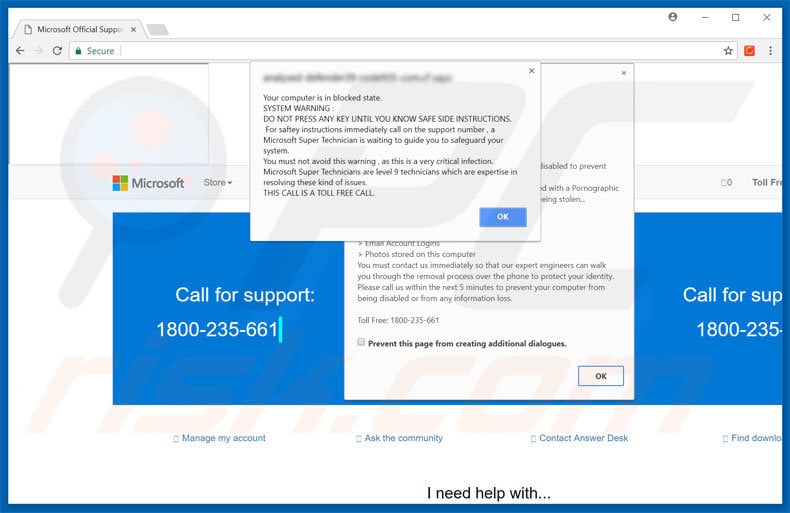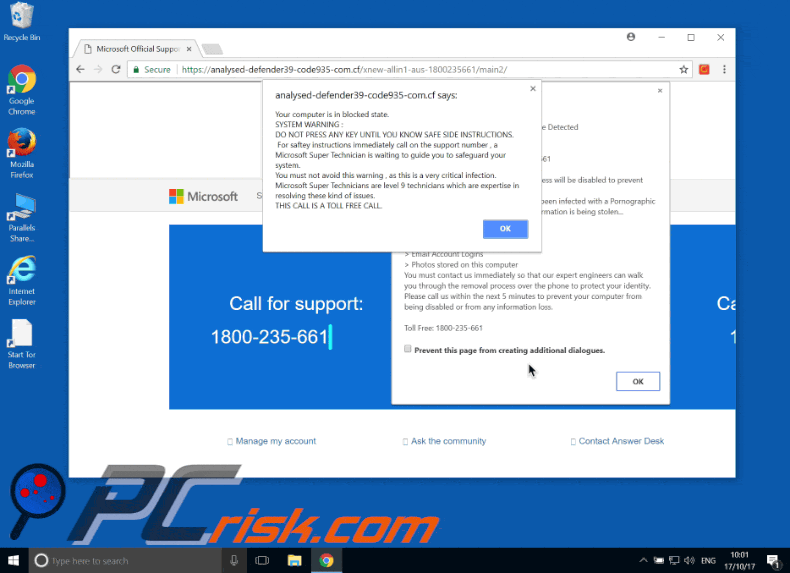Get free scan and check if your device is infected.
Remove it nowTo use full-featured product, you have to purchase a license for Combo Cleaner. Seven days free trial available. Combo Cleaner is owned and operated by RCS LT, the parent company of PCRisk.com.
What is SYSTEM WARNING?
Displayed by a malicious website, "SYSTEM WARNING" is a fake error message claiming that the system is damaged. Research shows that users often visit this website inadvertently - they are redirected by various potentially unwanted programs (PUPs).
Most infiltrate systems without consent. As well as causing redirects, potentially unwanted programs are also known to misuse system resources, deliver 'malvertising' ads (coupons, banners, pop-ups, etc.), and record user-system information.

This error states that system has detected an issue and, for this reason, users should immediately address Microsoft (Windows Operating System developers) technicians (via a toll-free telephone number ["1800-235-661"] provided) to resolve it. After contacting these people, users supposedly receive help.
In fact, "SYSTEM WARNING" is a scam - it is not genuine and has nothing to do with Microsoft. Criminals attempt to scare and trick users into calling and paying for technical support that is not required. These people often demand remote access to users' computers to stealthily install malware and/or change system settings.
Then they claim to find more issues and offer help for additional fees. For these reasons, never attempt to contact these people. The "SYSTEM WARNING" error can be removed by closing the web browser or restarting the system.
The aforementioned malicious websites (and potentially unwanted programs) are known to misuse system resources by performing background tasks (such as mining cryptocurrency), thus diminishing overall system performance. Potentially unwanted programs also deliver malicious ads.
To achieve this, developers employ various tools that enable placement of third party graphical content on any site. Therefore, the ads often conceal underlying content. Furthermore, some lead to malicious websites and/or run scripts that download and install malware.
Therefore, even accidental clicks can result in high-risk computer infections. Potentially unwanted programs record various data that might be personally identifiable. Developers sell the details to third parties. Therefore, PUPs pose a direct threat to your privacy and Internet browsing safety. Eliminate them immediately.
| Name | "SYSTEM WARNING" virus |
| Threat Type | Adware, Unwanted ads, Pop-up Virus |
| Symptoms | Seeing advertisements not originating from the sites you are browsing. Intrusive pop-up ads. Decreased Internet browsing speed. |
| Distribution methods | Deceptive pop-up ads, free software installers (bundling), fake flash player installers. |
| Damage | Decreased computer performance, browser tracking - privacy issues, possible additional malware infections. |
| Malware Removal (Windows) |
To eliminate possible malware infections, scan your computer with legitimate antivirus software. Our security researchers recommend using Combo Cleaner. Download Combo CleanerTo use full-featured product, you have to purchase a license for Combo Cleaner. 7 days free trial available. Combo Cleaner is owned and operated by RCS LT, the parent company of PCRisk.com. |
"SYSTEM WARNING" is virtually identical to Your Windows Infected With Viruses, Microsoft Warning Alert, Ransomware Detected, and dozens of other fake error messages displayed by malicious sites. All claim that the system is damaged, however, these claims are false - fake errors such as "SYSTEM WARNING" are designed only to extort money from unsuspecting users.
Research shows that potentially unwanted programs are often very similar. By offering various "useful features", PUPs attempt to give the impression of legitimacy, however, only a small fraction provide the features promised - most are useless.
Their real purpose is to generate revenue for the developers. Rather than (or, in rare cases, together with) enabling the functionality promised, PUPs promote malicious websites (by causing unwanted redirects), diminish system performance, deliver malicious ads (via the "Pay Per Click" advertising model), and gather system information.
How did adware install on my computer?
Although some PUPs have official download websites, developers usually proliferate them using the aforementioned malicious ads and via a deceptive marketing method called "bundling" (stealth installation of third party software together with regular programs). Developers are aware that many users rush the download/installation processes and skip steps.
Therefore, they hide "bundled" apps within the "Custom/Advanced" settings, or other sections of the download/installation processes. By carelessly skipping steps (and clicking various ads), users expose their systems to risk of various infections and compromise their privacy.
How to avoid installation of potentially unwanted applications?
The main reasons for computer infections are poor knowledge and careless behavior. The key to computer safety is caution. Therefore, be cautious when browsing the Internet and when downloading/installing software. Cyber criminals invest many resources into designing malicious ads.
Most appear legitimate, however, they usually lead to suspicious websites such as, for example, surveys, adult dating sites, pornography, gambling, etc. If you encounter such ads, uninstall all suspicious programs and browser extensions. Furthermore, select the "Custom/Advanced" settings and carefully analyze each download/installation step.
Third party download/installation tools often bundle PUPs (criminals monetize these tools by promoting rogue programs). Therefore, download your software from official sources only using a direct download link.
The appearance of "SYSTEM WARNING" scam pop-up (GIF):

Text presented within SYSTEM WARNING pop-up:
Your computer is in blocked state.
SYSTEM WARNING:
DO NOT PRESS ANY KEY UNTIL YOU KNOW SAFE SIDE INSTRUCTIONS.
For safety instructions immediately call on the support number. A Microsoft Super Technician is waiting to guide you to safeguard your system.
You must now avoid this warning, as this is a very critical infection, Microsoft Super Technicians are level 9 technicians which are expertise in resolving theses kind of issues. THIS CALL IS A TOLL FREE CALL. Toll Free: 1800-235-661
Instant automatic malware removal:
Manual threat removal might be a lengthy and complicated process that requires advanced IT skills. Combo Cleaner is a professional automatic malware removal tool that is recommended to get rid of malware. Download it by clicking the button below:
DOWNLOAD Combo CleanerBy downloading any software listed on this website you agree to our Privacy Policy and Terms of Use. To use full-featured product, you have to purchase a license for Combo Cleaner. 7 days free trial available. Combo Cleaner is owned and operated by RCS LT, the parent company of PCRisk.com.
Quick menu:
- What is "SYSTEM WARNING" virus?
- How to identify a pop-up scam?
- How do pop-up scams work?
- How to remove fake pop-ups?
- How to prevent fake pop-ups?
- What to do if you fell for a pop-up scam?
How to identify a pop-up scam?
Pop-up windows with various fake messages are a common type of lures cybercriminals use. They collect sensitive personal data, trick Internet users into calling fake tech support numbers, subscribe to useless online services, invest in shady cryptocurrency schemes, etc.
While in the majority of cases these pop-ups don't infect users' devices with malware, they can cause direct monetary loss or could result in identity theft.
Cybercriminals strive to create their rogue pop-up windows to look trustworthy, however, scams typically have the following characteristics:
- Spelling mistakes and non-professional images - Closely inspect the information displayed in a pop-up. Spelling mistakes and unprofessional images could be a sign of a scam.
- Sense of urgency - Countdown timer with a couple of minutes on it, asking you to enter your personal information or subscribe to some online service.
- Statements that you won something - If you haven't participated in a lottery, online competition, etc., and you see a pop-up window stating that you won.
- Computer or mobile device scan - A pop-up window that scans your device and informs of detected issues - is undoubtedly a scam; webpages cannot perform such actions.
- Exclusivity - Pop-up windows stating that only you are given secret access to a financial scheme that can quickly make you rich.
Example of a pop-up scam:

How do pop-up scams work?
Cybercriminals and deceptive marketers usually use various advertising networks, search engine poisoning techniques, and shady websites to generate traffic to their pop-ups. Users land on their online lures after clicking on fake download buttons, using a torrent website, or simply clicking on an Internet search engine result.
Based on users' location and device information, they are presented with a scam pop-up. Lures presented in such pop-ups range from get-rich-quick schemes to fake virus scans.
How to remove fake pop-ups?
In most cases, pop-up scams do not infect users' devices with malware. If you encountered a scam pop-up, simply closing it should be enough. In some cases scam, pop-ups may be hard to close; in such cases - close your Internet browser and restart it.
In extremely rare cases, you might need to reset your Internet browser. For this, use our instructions explaining how to reset Internet browser settings.
How to prevent fake pop-ups?
To prevent seeing pop-up scams, you should visit only reputable websites. Torrent, Crack, free online movie streaming, YouTube video download, and other websites of similar reputation commonly redirect Internet users to pop-up scams.
To minimize the risk of encountering pop-up scams, you should keep your Internet browsers up-to-date and use reputable anti-malware application. For this purpose, we recommend Combo Cleaner Antivirus for Windows.
What to do if you fell for a pop-up scam?
This depends on the type of scam that you fell for. Most commonly, pop-up scams try to trick users into sending money, giving away personal information, or giving access to one's device.
- If you sent money to scammers: You should contact your financial institution and explain that you were scammed. If informed promptly, there's a chance to get your money back.
- If you gave away your personal information: You should change your passwords and enable two-factor authentication in all online services that you use. Visit Federal Trade Commission to report identity theft and get personalized recovery steps.
- If you let scammers connect to your device: You should scan your computer with reputable anti-malware (we recommend Combo Cleaner Antivirus for Windows) - cyber criminals could have planted trojans, keyloggers, and other malware, don't use your computer until removing possible threats.
- Help other Internet users: report Internet scams to Federal Trade Commission.
Share:

Tomas Meskauskas
Expert security researcher, professional malware analyst
I am passionate about computer security and technology. I have an experience of over 10 years working in various companies related to computer technical issue solving and Internet security. I have been working as an author and editor for pcrisk.com since 2010. Follow me on Twitter and LinkedIn to stay informed about the latest online security threats.
PCrisk security portal is brought by a company RCS LT.
Joined forces of security researchers help educate computer users about the latest online security threats. More information about the company RCS LT.
Our malware removal guides are free. However, if you want to support us you can send us a donation.
DonatePCrisk security portal is brought by a company RCS LT.
Joined forces of security researchers help educate computer users about the latest online security threats. More information about the company RCS LT.
Our malware removal guides are free. However, if you want to support us you can send us a donation.
Donate
▼ Show Discussion